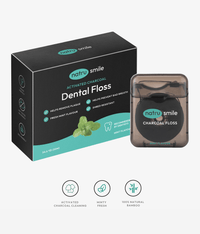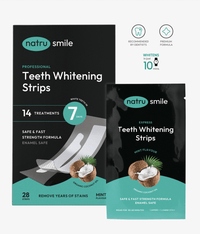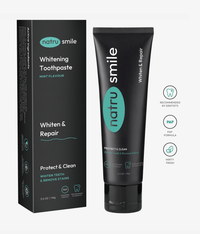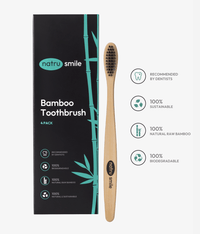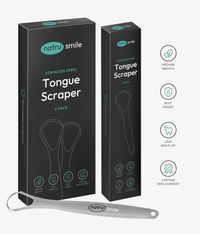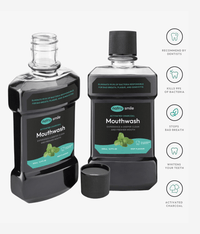
All products are certified by dental expert Dr. Greg Grillo
Veneers are a fantastic solution if you’re looking to improve your smile, with the market expected to be worth 2.3 billion USD by 2028. They are thin, custom-made shells designed to fit over the front surface of your teeth and can be used to correct a range of dental issues, such as chips, gaps between your teeth, or even discoloration. It’s almost like instant natural teeth whitening!
But with so many different shades of veneers, how can you be sure that you’re making the right decision? Read on for some tips that will help you find the perfect match for your smile.
How Are Veneers Put On?
The process begins with a consultation with your dentist in which you will discuss what you would like to achieve aesthetically. Your dentist will then take impressions of your teeth so that the veneers can be custom-made to fit perfectly over them. They may also need to remove some enamel from the surface of your teeth in order to make them a more suitable shape for the veneers.
Once your custom-made veneers are ready, they will be applied with a special bonding solution and hardened with a light source. This process is painless and relatively quick; most people can have their new veneers fitted within one appointment.
There are also other types of veneers, such as gum veneers for receding smiles to mask uneven gums and snap-on veneers that don’t require extensive dental work. For those that simply want to fix chips or cracks in the tooth, you may want to consider between dental bonding vs veneer, as the former may be more suitable for minor repairs.
Gum veneers can be used to hide discoloration or even out misshapen gum lines, creating an overall more aesthetically pleasing look. They may also be recommended for people looking to correct overly large gaps between their teeth as they can help to make them look more symmetrical. Snap-ons can provide that instant makeover, but they won’t be a perfect copy of your teeth.
Pros And Cons Of Veneers
Veneers are an excellent solution for anyone looking to improve the appearance of their smile. But as with any procedure, there are both pros and cons that you should be aware of before making your decision:
Pros Of Veneers
- Veneers provide a more natural-looking result than other treatments, such as crowns or bridges
- Some can last up to twenty years if properly cared for
- The color and shape can be customized to suit your individual needs
- They are relatively painless to have fitted
- Veneers can improve the overall appearance of your smile and boost your confidence
Cons Of Veneers
- Veneers can be expensive; they are not likely covered by insurance
- The enamel on your teeth will need to be removed in order for the veneers to fit properly, which could cause sensitivity or discomfort afterward
- They are irreversible; once they are fitted, there is no going back
- You won’t be able to whiten composite veneers or any type of veneers, for that matter
What Is A Veneer Color Chart?
A veneer shade chart is a helpful tool used by dentists to help patients select the right shade and color of their veneers. The charts are usually made up of different dental veneer colors ranging from lightest to darkest, with each one representing a specific level of brightness or darkness.
While each veneer shade guide will be slightly different depending on the manufacturer, most will include a few basic color palettes and shades, such as A - D (lightest to darkest) or 1 - 7 (very light to very dark). For instance, a dentist may recommend shade A2 if you’re looking for a natural, subtle whitening effect.
By comparing your current tooth shade against the ones on the chart, you’ll be able to pick out the one that best matches your natural teeth and make sure you get great results from your veneers. Let’s look at some of the best tips for choosing the right veneer color and shade.
What To Consider When Choosing Veneers
Although you might think that choosing from different colors of veneers is as simple as picking the shade you like best, there are actually several factors to consider when making your selection.
Facial Characteristics
While facial characteristics won’t necessarily determine the color of your veneers, they will help you decide which shape is most suitable for you. For instance, if you have a round face, then a longer veneer might complement your features better than a short, round one would. Oval-shaped faces, on the other hand, will suit square veneers to help fill out and widen the face.
Your Age And Gender
If you’re a younger person, then brighter shades will work best, whereas if you’re older, then darker shades may be more appropriate as teeth tend to yellow with age. Your teeth change with age - they get shorter and flatter from regular wear, and smiles generally become narrower.
As for gender, women tend to prefer lighter colors, while men usually opt for slightly darker ones. However, age and gender don’t come with set rules, and you should go for the color that best suits your individual look.
Natural Appearance
If you’re going for a more natural look, then you should pick a shade that matches your natural teeth as closely as possible. To do this, take a photo of your teeth or look in the mirror and compare your teeth to the veneer shades chart available at your dentist's office. This will give you an idea of which shades are most similar to yours, giving you the best chance of achieving a subtle yet effective result.
It’s important not to go too light or too dark with your veneers – if they are too light, they will look unnatural and fake, while if they are too dark, then your teeth may appear discolored and dull.
Skin Tone
Your skin tone can also influence which shade of veneer will be most flattering. If you have a fair complexion, then a slightly darker color may complement your features better than lighter shades would. Conversely, those with darker complexions should opt for more neutral tones to avoid clashing with their natural coloring.
Veneer Sizes
All this talk about color and shade, but what about the size? Depending on the shape and size of your teeth, you may need small or large veneers for a natural look. Smaller veneers are better suited for those with narrow smiles, while larger ones can be used to fill in gaps between teeth.
Veneers can also help to even out the length of your teeth, so this is something to consider when making your selection. In some cases, your dentist may have to decide between a dental crown vs veneer if you need a large veneer to cover your tooth.
Types Of Veneer Color Charts
While we’ve talked about the general concept of a veneer color chart, we’ll also dive deeper into the details of the most popular color palettes.
Hollywood White
The Hollywood White palette is made up of bleached shades of white - BL1 being the most brilliant shade. It’s designed to mimic the bright white smiles you often see on movie and TV stars, providing an intense whitening effect that can make your teeth look up to eight shades lighter. If you want a dramatic transformation and don’t mind making a bold statement with your smile, this could be the perfect option for you!
Natural White
The Natural Whites palette is a great choice for people who want a more subtle, natural-looking result - typically A1, A2, and A3 shades. These are the lightest of all the shades and will give you a bright, natural-looking smile without the risk of looking too “fake” or overly white. The shades are designed to blend in with your existing teeth, giving you a brighter but still realistic look.
Still have questions about veneer color options and shades? Here are some of the most common ones:
Is B1 A Good Shade For Veneers?
B1 is a good shade for veneers as it offers a natural and subtle whitening effect. It isn't too light or too dark, so it is a great choice for those who want to brighten their teeth without going overboard.
Is B2 Or A1 Whiter?
Although it may not sound like it, B2 is actually the whiter of the two shades. A1 offers a more natural look and would be better suited for those who just want to improve their tooth's appearance slightly without making it too obvious that they have veneers.
Remember that the actual shade of your veneers will depend on the manufacturer and product you choose, so always make sure to consult with your dentist before making a final decision.
What Are The Most Natural-Looking Veneers?
The most natural-looking veneers are those that match the shade of your natural teeth as closely as possible. Look for shades like A2 or B1 for a subtle yet noticeable result. If we're talking about the overall look, then the thinnest and most translucent veneers will create the most realistic result.
Can You Choose The Shade Of Composite Veneers?
Yes, you can choose the shade of composite veneers just like you would with porcelain veneers. Composite veneers are not as durable or long-lasting as porcelain, lasting only about 2.5 - 5 years compared to the 5 - 25 years of porcelain.
What Are Gum Veneers?
Gum veneers for receding smiles are designed to mask uneven gums. They are usually professionally made from a composite material and have a pinkish hue to mimic the natural color of your gums.
These can be used to hide discoloration or even out misshapen gum lines, creating an overall more aesthetically pleasing look. They may also be recommended for people looking to correct overly large gaps between their teeth as they can help to make them look more symmetrical.


